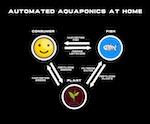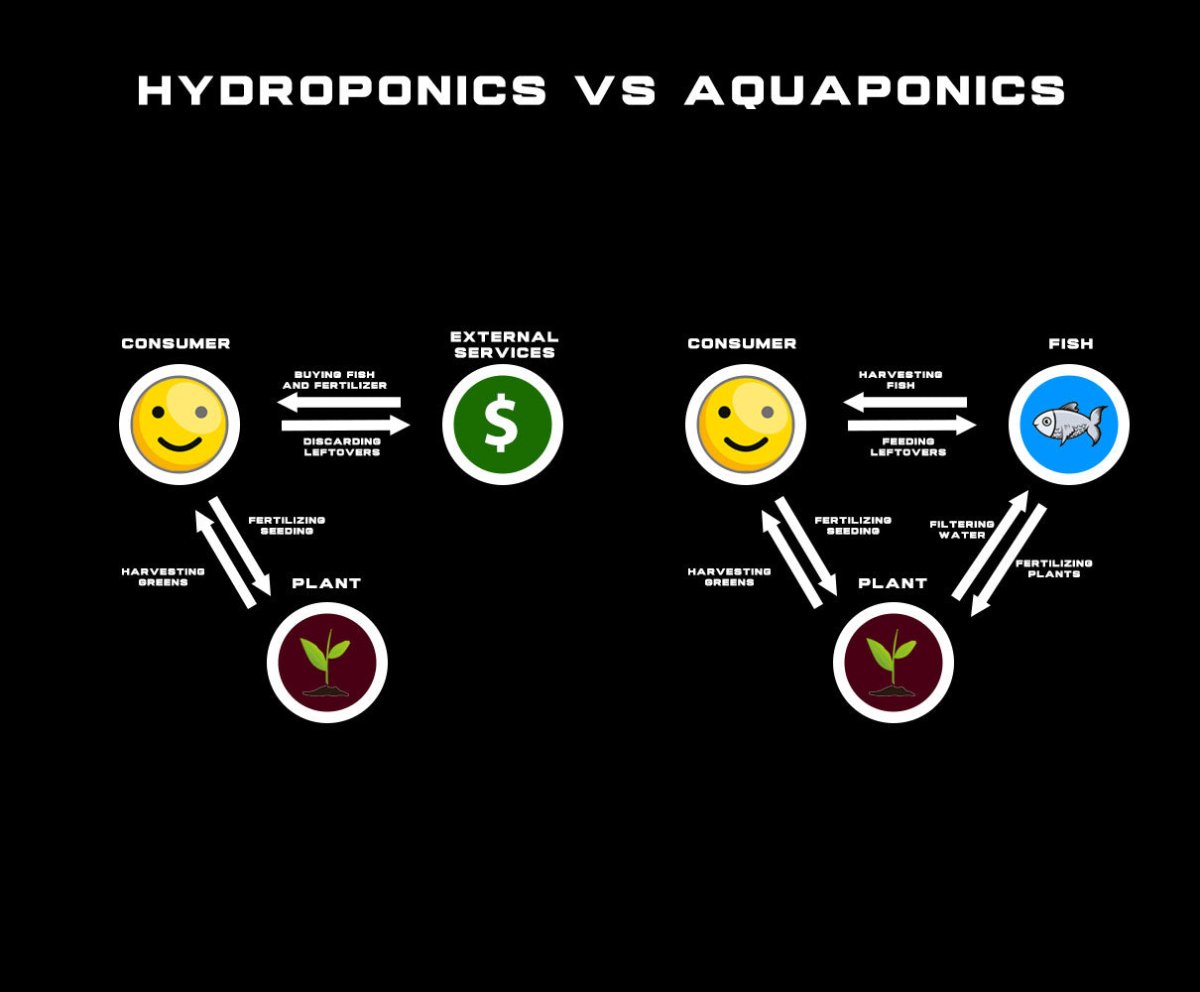
Five Facts About Hydroponics vs Aquaponics:
- ✅ Aquaponics fights overfishing, pollution of the ocean, desertification and deforestation
- ✅ Hydroponics fights desertification and deforestation.
- ✅ Aquaponics efficiently recycles all available resources at home.
- ✅ Aquaponics is the most biodiverse option in the world.
- ✅ Aquaponics water is life - Hydroponics water is dead.
Key Differences Between Aquaponics and Hydroponics
Aquaponics and hydroponics differ in several key aspects.
Firstly, aquaponics combines hydroponics with aquaculture, utilizing fish waste as a natural fertilizer, while hydroponics solely relies on nutrient solutions which often derive from fossil fuel.
Secondly, the maintenance and management of an aquaponics system can be more complex due to the involvement of both plants and fish. Even though automation can take away a lot of work resulting in more harvest and less work than hydroponics systems.
Additionally, aquaponics is considered more sustainable and environmentally friendly, as it is a circular system and doesn’t require chemical fertilizer.
For an in depth cost analysis of an automated aquaponics system click here.
Hydroponics, on the other hand, requires less monitoring and easier to control however I often found myself having to change the nutrient solution because only 1 or 2 nutrients were used up while others were there in excess amounts. Resulting in nutrient burns in the plants.
To better understand the differences, let's explore the key distinctions between aquaponics and hydroponics in the table below:
|
Aspect |
Aquaponics |
Hydroponics |
|---|---|---|
|
Nutrient Source |
Fish waste provides nutrients |
Nutrient solutions are used |
|
Complexity |
Combines hydroponics and aquaculture |
Purely focuses on plants |
|
Maintenance |
Requires monitoring of both plants and fish |
Primarily focuses on plant care and nutrient solution |
|
Sustainability |
Reduces water consumption, waste production and overfishing |
Moderate water usage and waste production |
It is worth mentioning that both aquaponics and hydroponics offer unique benefits and can be adapted to various settings, from small-scale home gardens to large commercial operations.
Each method has its advantages and considerations, allowing growers to choose the system that aligns best with their goals and available resources.
Hydroponics is an easy and simple way to get into growing your own food. With more experience you can adapt that knowledge into aquaponics and continue your journey to a self sufficient home.
Combining a worm composter with a hydroponics system is a sustainable way to use the fertilizer created out of leftovers.
In an interesting real-life example, a farmer named John embraced a hydroponics system to grow lettuce efficiently in an urban environment. By utilizing nutrient-rich solutions, he managed to maximize crop yield while minimizing water usage. John's success with hydroponics inspired other local farmers to adopt similar practices, contributing to a more sustainable and innovative agricultural landscape in their community.
In Depth Comparison
Hydroponics and aquaponics are two modern methods of growing plants without soil. Hydroponics involves growing plants in a nutrient-rich solution, while aquaponics combines hydroponics with fish farming. These methods provide a controlled environment for plant growth, allowing for year-round cultivation and increased crop yields. While both methods have their advantages and disadvantages, understanding the differences between hydroponics and aquaponics is essential for selecting the most suitable system for sustainable and efficient plant cultivation.
While hydroponics challenges are often related to the nutrient solution, while in aquaponics the challenges are more allencompassing.
|
Feature |
Hydroponics |
Aquaponics |
|
Farming Method |
Soilless growing method using liquid fertilizer to grow plants |
Combines aquaculture and hydroponics |
|
Input |
usually synthetic fertilizer without all essential micronutrients |
Fish waste, water, and fish feed |
|
Output |
Vegetables |
Harvestable fish and vegetables |
|
Water Usage |
Uses more water than aquaponics because no fish is produced. The synthetic fertilizer cost water to produce |
Significantly reduces water consumption compared to traditional fish farming and agriculture |
|
Nutrient Source |
Synthetic fertilizer derive from fossil fuels |
Fish waste is used as a natural fertilizer for plants |
|
Chemical Usage |
chemical fertilizer compromise the immune system of the plant and more pesticides needed |
No chemical fertilizers or pesticides are needed |
|
Efficiency |
Highly efficient use of space and easy to set up |
Highly efficient use of space and resources. Circular system with the consumer |
|
Micronutrients |
Lacks many micronutrients so taste and health is not the same |
Rock dust adds all essential micronutrients needed |
|
Biodiversity |
plants, bacteria, fungi, insects, birds |
fish, snails, crustacean, worms, bacteria, fungi, plants, insects, birds |
|
Sustainability |
Produce food at home and rely less on supermarket produce |
Creates a closed-loop system with minimal environmental impact and produces essential protein and fat to eat all the time. |
|
Eco-Friendly |
Reduces harmful effect of agriculture like deforestation and desertification |
Reduces water pollution, overfishing, deforestation and desertification, preserves natural resources |
|
Scalability |
Suitable for small-scale and large-scale operations |
Suitable for small-scale and large-scale operations |
|
Cost |
Low if you build it yourself |
fish tank and grow bed are quite expensive, second hand makes it affordable |
|
Profitability |
Medium - |
High - more efficient because no need to buy fertilizer |
Technical Aspects of Hydroponics and Aquaponics
A hydroponics system usually can be completely free of tech but for the best growth you want a pump to aerate and move the solution to the plants. This way you can make use of height by integrating a vertical farming structure. If you want to completely automate your hydroponics system you need advanced knowledge with arduino, sensors and dosing pumps for perfect nutrient solutions.
Aquaponics systems can also run completely free of tech but then you can't have dense fish stocks. For maximizing the potential of your system you need an aerator for oxygen and a pump to move the water from the fish tank to the grow bed. With a timer you can automate this process. For complete automation you can add a fish feeder. All you have to do now is add the fish and seed the plants and let the system do the work. Here and there you can add your kitchen scraps for extra healthy fish nutrition.
Key Takeaways:
- Aquaponics combines aquaculture (fish farming) and hydroponics (soilless plant cultivation) in a symbiotic system. Fish waste provides nutrients for the plants, while the plants purify the water for the fish.
- Hydroponics is a method of growing plants without soil, using a nutrient solution and a growing medium to provide nourishment and support. The plants receive the exact nutrients they need, resulting in faster growth and higher yields.
- Aquaponics is more resource-efficient than hydroponics, as it utilizes the waste products of the fish to nourish the plants, reducing the need for artificial nutrients. It also requires less water and prevents overfishing, making it a sustainable choice for agriculture.
In hydroponics, plants receive nutrients directly from the nutrient solution, which eliminates the need for soil. This method allows for precise control over the nutrient levels, pH, and other environmental factors, resulting in optimal plant growth. Additionally, hydroponics uses less water compared to traditional soil-based cultivation methods, making it a more water-efficient option. However, it requires regular monitoring and adjustment of nutrient levels to ensure proper plant nutrition.
On the other hand, aquaponics combines hydroponics with aquaculture, creating a symbiotic relationship between fish and plants. Fish waste provides the nutrients for plant growth, while plants filter the water for the fish. This integrated system offers benefits such as efficient nutrient cycling, reduced water consumption, and the production of both fish and plants. This also offers the option to feed our leftovers to the fish instead of turning it into fertilizer which would be a waste of protein. However, maintaining a balance between the fish and plants can be challenging, as any imbalance can negatively affect the entire system.
Aquaponics
Aquaponics is a sustainable farming method that combines aquaculture (raising fish) and hydroponics (cultivating plants in water). In aquaponics systems, the waste produced by the fish is used as nutrients for the plants, while the plants filter the water for the fish. This mutually beneficial relationship creates a closed-loop system that requires less water and no chemical fertilizers. Additionally, aquaponics allows for the production of both fish and vegetables in a smaller space, making it a highly efficient and environmentally friendly farming technique.
One unique aspect of aquaponics is its ability to integrate fish and plant cultivation. This symbiotic relationship creates a sustainable and self-regulating system. Additionally, aquaponics can be implemented in various settings, including urban areas where space is limited. Its efficient use of resources and environmentally friendly practices make it an attractive option for automated modern farming. To improve your aquaponics system, consider the following suggestions:
- Maintain a balanced ecosystem: Regularly monitor the water quality and nutrient levels in your aquaponics system. This will ensure optimal conditions for both the fish and plants to thrive.
- Choose compatible fish and plants: Select fish species that can coexist with the plants you wish to cultivate. Similarly, choose plants that can thrive in the aquatic environment provided by the fish tank.
- Monitor water temperature: Maintain an appropriate water temperature for both the fish and plants. Fluctuations in temperature can impact their growth and overall health.
- Provide adequate aeration and filtration: Properly oxygenate the water and implement effective filtration systems to keep the system clean and prevent any buildup of toxins.
- Easy to Automate: All it takes to automate an aquaponics system is to use a mechanical timer for the grow bed pump and the fish feeder.
Are you looking for a full step-by-step guide for an automated aquaponics system? Click Here
By following these suggestions, you can create a successful and productive aquaponics system that maximizes the benefits of this innovative farming technique.
Hydroponics
Hydroponics is a sophisticated method of growing plants without soil. Instead, a nutrient-rich solution is used to provide essential minerals directly to the plant roots. This innovative technique offers several advantages:
- Efficient use of resources: Hydroponics allows plants to grow in a controlled environment, optimizing water usage by recycling it within the system. This conserves water and nutrients, making it more sustainable than traditional farming methods.
- Higher yields in smaller spaces: Due to the precise control over growing conditions, hydroponics enables plants to grow faster and produce larger yields in a smaller area. This makes it ideal for urban areas or limited space scenarios.
- Reduced risk of pests and diseases: By eliminating soil, hydroponics eliminates many common pests and diseases that thrive in traditional farming systems. This reduces the need for pesticides and allows for the production of healthier, pesticide-free crops.
Furthermore, hydroponics offers the flexibility to grow plants all year round, making it an attractive option for both commercial and home gardeners. With its innovative approach to cultivation, hydroponics has gained popularity as a sustainable and efficient method of plant production.

Conclusion
Hydroponics and aquaponics offer unique sustainable benefits for growing plants without soil. Although both methods have their advantages, aquaponics stands out by combining hydroponics with aquaculture. This integrated system allows plants to receive essential nutrients from fish waste, resulting in a sustainable and symbiotic relationship between plants and fish. With aquaponics, farmers can cultivate both crops and fish efficiently, creating a closed-loop system that minimizes waste and maximizes productivity. Additionally, aquaponics requires less water and energy compared to traditional farming methods. Implementing aquaponics can be a wise choice for individuals looking for an environmentally friendly and highly efficient way to grow crops and raise fish simultaneously.
If you want to live more sustainable and healthy you can't go wrong with either. So don't overthink and start with a DIY hydroponics system. It's cheap and easy to maintain.
FAQs about Hydroponics Vs Aquaponics
1. What are the fundamental principles of aquaponics and hydroponics?
Aquaponics combines aquaculture and hydroponics, creating a closed-loop system where fish waste provides nutrients for plants, and plants filter and purify the water for the fish. Hydroponics, on the other hand, relies on nutrient-rich water solutions to directly feed plants, eliminating the use of soil.
2. What are the key components of an aquaponics system?
An aquaponics system consists of fish tanks where aquatic species are housed, grow beds where plants are cultivated, and beneficial bacteria that convert fish waste into nitrates for plant absorption.
3. How does aquaponics work?
Aquaponics operates in a closed-loop cycle. Fish produce waste, which is converted into nitrites and nitrates by beneficial bacteria in the grow beds. Plants absorb these nitrates as nutrients, purifying the water, which is then recirculated back to the fish tanks.
4. What are the advantages of aquaponics over traditional soil-based farming?
Aquaponics offers resource efficiency by using less water, leftover recycling by feeding it, reduced environmental impact with recycling of water and nutrients, year-round cultivation, and the potential for organic and pesticide-free crop production.
5. What are the main challenges and limitations of aquaponics?
Aquaponics may have high initial setup costs due to the construction of fish tanks and grow beds. Maintenance and monitoring are also crucial, as the system requires consistent attention to balance fish health, bacterial activity, and plant growth. Additionally, certain crop varieties may not be suitable for aquaponics due to specific nutrient requirements or space constraints.
6. What are the key advantages of hydroponics?
Hydroponics offers resource efficiency with reduced water usage, faster plant growth, space efficiency with vertical systems, reduced pest and disease pressure, and the ability to cultivate crops year-round.
7. Which is better, hydroponics or aquaponics?
It depends on your goals and preferences. Hydroponics may be simpler and cleaner, while aquaponics is more eco-friendly and sustainable, integrating fish farming with plant cultivation.
8. What are 5 disadvantages of aquaponics?
- High Initial Setup Cost
- Complexity and Learning Curve
- Dependence on Electricity
- Balancing Ecosystem can be Challenging
- Fish Feed comes from ocean to supplement omega 3
9. Is aquaponics cheaper than hydroponics?
Aquaponics can be more expensive initially due to the additional components for fish farming, but if you eat or sell the fish it is more cost-effective in the long run due to reduced nutrient costs and making use of leftovers.
10. Why is aquaponics not profitable?
Aquaponics can be profitable, but challenges such as high initial costs, operational complexities, and market competition can impact profitability for big operations. Success in returning the investment in home operated systems is almost guaranteed in 1 - 2 years.









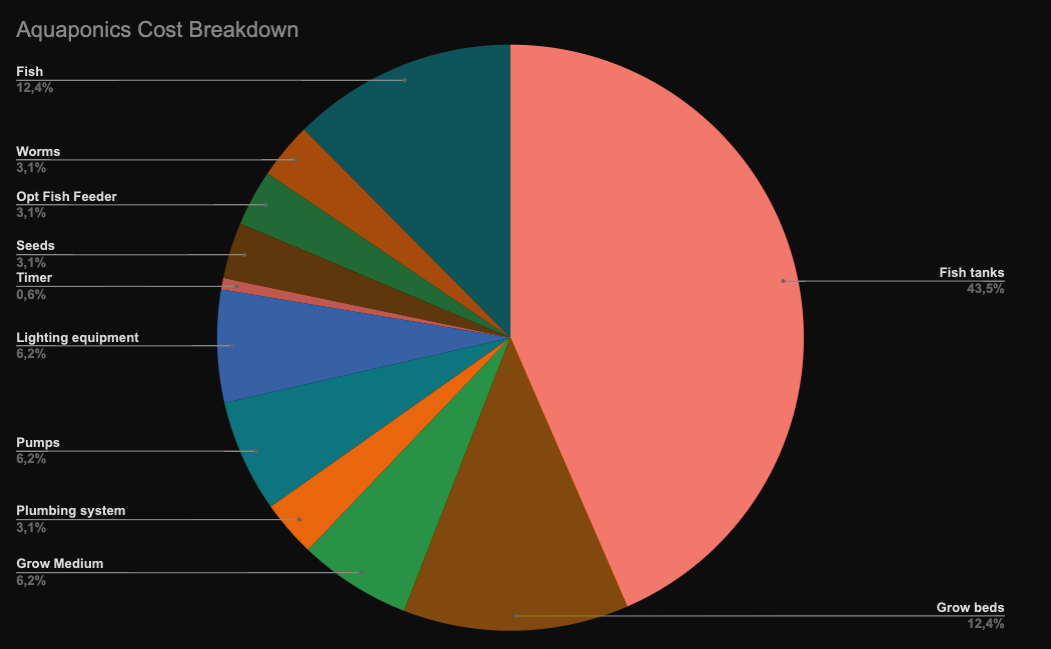
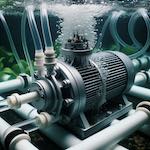
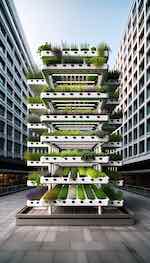
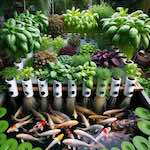
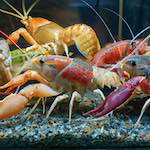
.jpeg)
